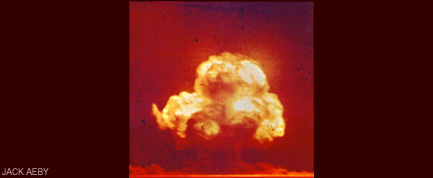
The world’s first atomic bomb test might have exposed unaware civilians in New Mexico to thousands of times the recommended level of public radiation exposure, according to reconstructed data in a new study.
The research, led by the Centers for Disease Control and Prevention (CDC), found that ingestion of radioactive materials—primarily from irradiated rainwater and goat’s milk—might have been a substantial contributor to public radiation exposure that was largely not accounted for.
The findings come on the 62nd anniversary of the world’s first atomic explosion and were presented at the recent annual meeting of the Health Physics Society.
‘Trinity’
The world’s first nuclear weapons test took place on July 16, 1945 in the desolate White Sands deserts of New Mexico. In a cryptic reference to a John Donne poem that he knew and loved, J. Robert Oppenheimer, lead physicist of the Manhattan Project and scientific director of the test, dubbed the location “Trinity.”
At 5:29:45 a.m. local time, a plutonium-based atomic bomb was detonated atop a 100-foot steel tower erected at Trinity specifically for the test. Scientists hoped that exploding the bomb at an elevated height would reduce the amount of radioactive dust raised by the explosion. They also needed to simulate the air-drop method of deployment that was eventually used by the real bombs.
The Trinity bomb was an exact replica of “Fat Man,” the second and last nuclear weapon ever used in war. Fat Man was detonated over Nagasaki, Japan less than a month after the Trinity test.
Get the world’s most fascinating discoveries delivered straight to your inbox.
Exploding with an energy equal to about 20 kilotons of TNT, the blast carved a crater in the Earth more than 1,000 feet wide and 10 feet deep. Radioactive fallout from the blast was detected as far away as Indiana.
Heat from the explosion was so intense that sand grains fused to form a reflective layer of radioactive, green glass, called “Trinitite,” on the desert floor.
Dangerous radiation
Because of its importance in the war, the Trinity test was conducted in secret. Little was known about the dangers of radiation exposure in the 1940s, so local residents were not warned or evacuated in advance of—or even following—the test. As a result, people in surrounding areas were exposed to radiation by breathing contaminated air, eating contaminated foods, and drinking affected water and milk. Some ranches were located within 15 miles of ground zero, and commercial crops were grown nearby.
In the hours after the blast, five monitoring teams traveled along local roads recording radiation levels. The highest radiation levels from Trinity were measured in a swath 12 miles long and one mile wide that started near an area 16 miles northeast of ground zero. Around nearby ranches, exposure rates around 15 Roentgen per hour were measured just three hours after detonation.
Currently, the Nuclear Regulatory Commission states that members of the public should not receive more than 2 millirem (about 0.002 Roentgen) of radiation in any one hour from external radiation sources in any public area. The exposure rates following the Trinity test were more than 10,000 times this recommended dose level.
T.E. Widner, the director of the new CDC study, said he thinks evacuations would have certainly been arranged if scientists and physicians had known about the long-term effects of radiation exposure, even if the publicity threatened the mission.
Trinity is now open twice a year to the public, on the first Saturdays of April and October for six hours each time. According to the public affairs office at White Sands, a one-hour visit to ground zero will result in a whole body exposure of one-half to one millirem. To put this in perspective, a U.S. adult receives 360 millirems on average every year from natural and medical sources.
- Top 10 Ways to Destroy Earth
- Labs Compete to Make New Nuclear Bomb


